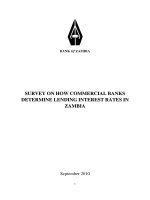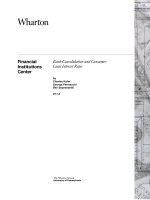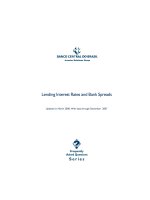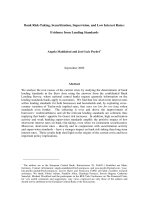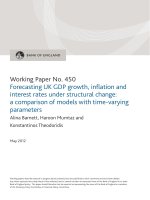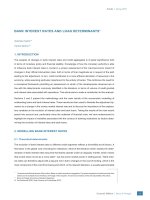Lending Interest Rates and Bank Spreads potx
Bạn đang xem bản rút gọn của tài liệu. Xem và tải ngay bản đầy đủ của tài liệu tại đây (132.13 KB, 29 trang )
Frequently
Asked Questions
Series
Lending Interest Rates and Bank Spreads
Updated in March 2008, With data through December 2007
Investor Relations Group
Lending Interest Rates and Bank Spreads
This paper is part of the Banco Central do Brasil’s “Frequently
Asked Questions” series. This series, which is produced by the BCB’s
Investor Relations Group (Gerin), provides background information
and analysis on economic data and issues of interest to investors and
the general public.
The Banco Central do Brasil is producing this series as part of
its ongoing efforts to enhance the transparency of the Brazilian
economy and economic policy, and to improve its communication with
the private sector.
1. What is the total amount of credit in the
Brazilian economy? How it is distributed? 7
2. How has earmarked credit evolved recently? 8
3. How is non-earmarked credit distributed
among borrowers? How has this stock of credit
evolved recently? 9
4. How has the stock of foreign currency-denominated
credit evolved recently? 10
5. What are the major types of non-earmarked credit
contracts in Brazil? 11
6. What is the average cost of bank creditin Brazil?
What is the average bank spread? 11
7. How have spreads on non-earmarked fixed
interest rate credits behaved recently? 12
8. What are the components of bank spreads in Brazil? 13
9. How much do reserve requirements contribute
to bank spreads? 14
10. Does the credit contract influence the spread? 15
11. Why is the bank spread between consumer and
corporate credit operations so different? 16
12. What role does collateral play in bank spreads? 16
13. What is the average maturity of bank credit in Brazil? 17
14. What has the BCB been doing to reduce
lending costs and bank spreads? 18
15. What is the effect of legal insecurity or legal
risk on credit and bank spreads? 18
16. What are payroll-deducted loans? How has this
credit instruments evolved recently? 19
17. What is a Bank Credit Bill (CCB)? 20
18. What is chattel mortage? What is its purpose? 20
Contents
19. What is micro-credit? 21
20. What is the implication of the new Bankruptcy
Law and the changes in the National Tax Code
for the credit market? 21
21. What measures have been adopted to increase
transparency and enhance competition in the
credit market? 22
22. What is Credit Risk Center (SCR)? 23
23. Where can I read more about lending
interest rates and bank spreads? 24
24. Where can I find current data? 26
7
Frequently Asked Questions
Lending Interest Rates and Bank Spreads
1. What is the total amount of credit in the Brazilian
economy? How it is distributed?
Total credit in Brazil stood at 34.7% of GDP at the end of 2007.
At end-December, financing and transfers from the Brazilian
Development Bank (BNDES) made up 17.2% of total credit, while
earmarked credit
1
to the housing and agricultural sectors represented
4.6% and 6.8% of total credit, respectively. Lending with non-
earmarked funds (i.e. funds not subject to directed-lending
requirements) represented 70.7% of total credit at the end of 2007.
Graph 1– Total Credit Distribution (December/2007)
1
Brazil’s directed-lending requirements specify that a fixed percentage of deposit liabilities
should be granted to the agriculture and housing sectors at government-set interest rates.
Source: Banco Central do Brasil
Other
Earmarked
Credit
0.8%
BNDES
17.2%
Housing
Credit
4.6%
Agricultural
Credit
6.8%
Credit to
Individuals
34.0%
Credit to
Corporate
29.3%
Non-
Earmarked
Credit
70.7%
Externally
Funded Credit
7.4%
8
Frequently Asked Questions
2. How has earmarked credit evolved recently?
Earmarked credit can be split into two categories, with different
characteristics:
- The credit supply to the agricultural sector and the amount of
credit granted by the BNDES have been strongly growing in recent
years, following the expansion of the farming sector and the
investment recovery in the period;
- After the strong nominal fall in mid-2001, caused by the recognition
of bad loans, credit to the housing sector has been widening as a result
of the favorable moment of the Brazilian economy, added to fall of interest
rates, the personal income increase and the credit supply growth.
Graph 3 – Total Earmarked Credit (R$ billion)
Source: Banco Central do Brasil
0
20
40
60
80
100
120
140
160
180
Jun
00
Dec
00
Jun
01
Dec
01
Jun
02
Dec
02
Jun
03
Dec
03
Jun
04
Dec
04
Jun
05
Dec
05
Jun
06
Dec
06
Jun
07
Dec
07
Housing Agricultural BNDES Others
9
Frequently Asked Questions
3. How is non-earmarked credit distributed among
borrowers? How has this stock of credit evolved
recently?
Out of the total R$659 billion in non-earmarked credit outstanding
at the end of 2007, R$316.8 billion (48.1%) were individual loans and
R$342.2 billion (51.9%) were corporate loans. Roughly R$68.6 billion
of corporate credit was denominated in foreign currency.
Despite the fact that the credit to GDP ratio in Brazil is quite
low compared to international standards, non-earmarked credit has
increased substantially over the past years. From June 2000 to
December 2007, the nominal supply of non-earmarked credit
increased to R$659 billion (24.5% of the GDP) from R$169.2 billion
(14.3% of the GDP). Over this period, nominal credit to individuals
was the most dynamic, increasing fourfold.
Graph 3 – Non-Earmarked Credit (R$ billion)
Source: Banco Central do Brasil
100
200
300
400
500
600
700
Jun
00
Dec
00
Jun
01
Dec
01
Jun
02
Dec
02
Jun
03
Dec
03
Jun
04
Dec
04
Jun
05
Dec
05
Jun
06
Dec
06
Jun
07
Dec
07
Individuals Corporates
10
Frequently Asked Questions
4. How has the stock of foreign currency-denominated
credit evolved recently?
Aggregate foreign currency-denominated credit, which includes
advances on export contracts (ACC), export notes, import financing,
and foreign currency-denominated loans has behaved differently from
the other types of non-earmarked credit. The variation is due not
only to exchange rate movements, but also to volatility in perceived
country risk. As can be seen in Graph 4, the stock of foreign currency-
denominated credit has declined gradually through 2002 as foreign
lenders reduced credit lines to Brazilian corporations and banks. Since
2003, however, FX-denominated credits have shown signs of recovery,
especially for ACC advances even with the Real appreciation. The
recent upward trend is related to demand widening for these financing
lines following the expansion of Brazilian external trade.
Graph 4 – Foreign Currency-Denominated Credit (US$ billion)
Source: Banco Central do Brasil
2
4
6
8
10
12
14
16
18
Jun
00
Dec
00
Jun
01
Dec
01
Jun
02
Dec
02
Jun
03
Dec
03
Jun
04
Dec
04
Jun
05
Dec
05
Jun
06
Dec
06
Jun
07
Dec
07
ACC FX-Denominated Loans Import Financing and Others
11
Frequently Asked Questions
5. What are the major types of non-earmarked credit
contracts in Brazil?
Credits in Brazil are contracted with fixed and floating real-
denominated interest rates, and with FX-linked (effectively dollar-
denominated) interest rates. Most credits to individuals, including personal
credit, overdraft credit and credit for the purchase of goods, have fixed
interest rates. There are also several types of corporate credits with
fixed interest rates, including hot money, working capital, discounts of
trade bills, credit for the purchase of goods, vendor (wholesaler
rediscounts of certain types of retail receivables), and guaranteed
accounts (a kind of overdraft account for companies).
Some types of corporate credits, such as guaranteed account, credit
for the purchase of goods and working capital are also negociated at
floating rates, which are linked to benchmark interest rates such as the
Selic overnight rate
1
or the One-day Interbank Deposit rate (DI)
2
.
Dollar-denominated loans are also priced at floating interest rates
and involve foreign funds (ACCs, export notes and the so-called
“Operações 63”).
For further information regarding the characteristics of each of
these operations, please access the glossary of the Press Release
“Monetary Policy and Financial System credit operations” available on
/>6. What is the average cost of bank credit in Brazil?
What is the average bank spread?
In December 2007 the average interest rate on non-earmarked
bank credit stood at 33.8% p.a., while the average bank spread, which
1
The Selic Overnight rate is calculated by taking the weighted average of the interest
rate on 1-day inter-bank financing operations, collateralized by federal domestic
securities and traded as repo-operations (which implies interest rates with uniform credit
risk).
2
The Average One-day Interbank Deposit Rate (DI) represents fund transfer between
financial institutions and is calculated by CETIP – Custody and Settlement. It is
expressed as a percentage rate per annum compounded daily based on a 252-day year.
12
Frequently Asked Questions
represents the difference between the lending and funding interest
rates, stood at 22.4% p.a. Graph 5 illustrates the evolution of the
average bank spread since January 2001 (including fixed, floating
and FX-linked interest rate operations).
There are significant differences between interest rates and
spreads on loans to individuals and loans to companies. The average
spread on corporate loans, which stood at 11.9% p.a. in December
2007, is roughly 1/3 of the average spread on lending to individuals,
which stood at 33.8% in the same month.
Graph 5 – Bank Spread – Non-Earmarked Credit (% p.a.)
Source: Banco Central do Brasil
7. How have spreads on non-earmarked fixed interest
rate credits behaved recently?
The average spread on non-earmarked fixed rate credits fell to
28.4% in December 2007 from 51.3% in October 1999. However,
this reduction was not linear over time.
10
16
22
28
34
40
46
52
58
64
Jun
00
Dec
00
Jun
01
Dec
01
Jun
02
Dec
02
Jun
03
Dec
03
Jun
04
Dec
04
Jun
05
Dec
05
Jun
06
Dec
06
Jun
07
Dec
07
Total Corporates Individuals
13
Frequently Asked Questions
Between late 1999 and mid-2001, the average spread on fixed
rate credits fell significantly, particularly for credits to individuals.
Since the second half of 2001, restrictive monetary policy and
macroeconomic volatility, added to the 2001 and 2002 financial markets
turmoil were responsible for an increase in the spreads, reversed in the
second quarter of 2003. From then, the spreads recorded a downward
trend as a result of the favorable environment provided by the
consolidation of macroeconomic stability.
Graph 6 – Bank Spread – Fixed Interest Rate Credits (% p.a.)
Source: Banco Central do Brasil
8. What are the components of bank spreads in Brazil?
With the goal of identifying the factors that contribute to bank
spreads, the BCB used sample data from banks balance sheets to
decompose the average spread into the following factors:
administrative expenses, direct and indirect taxes, costs associated
with defaults, and banks’ “net margin”. According to the most recent
18
24
30
36
42
48
54
60
66
72
78
84
Oct
99
May
00
Dec
00
Jul
01
Feb
02
Sep
02
Apr
03
Nov
03
Jun
04
Jan
05
Aug
05
Mar
06
Oct
06
May
07
Dec
07
Total Corporates Individuals
14
Frequently Asked Questions
data, released in the “Relatório de Economia Bancária e Crédito -
2006” of December 2006
(available on />?SPREAD) the spread on the fixed interest rate credits could be
decomposed into: administrative expenses (16.9%), taxes (15.9%),
reserve requirements (4.7%), costs associated with defaults (43.4%),
and a residual (19%). The “residual” represents bank’s net margin.
Table 1 shows the spread decomposition for fixed interest rate loans
on an annual basis from 2001 to 2006.
Table 1 – Bank Spread Composition (%)
Source: Banco Central do Brasil
9. How much do reserve requirements contribute to
bank spreads?
Brazil’s reserve requirements contribute significantly to the
country’s bank spreads by reducing its ability to increase credit. Non-
remunerated reserve requirements on demand deposits stood at 45%
in December 2007. The Central Bank also requires an 8%
remunerated requirement on demand deposits. Reserve requirements
for time deposits and saving accounts stood at 15% and 20%,
respectively, in addition to the extra remunerated requirements of
2001 2002 2003 2004 2005 2006
1 - Total Spread 100.0 100.0 100.0 100.0 100.0 100.0
2 - Administrative Expenses 16.8 14.7 19.5 19.8 17.2 16.9
3 - Costs of default 30.7 31.2 31.7 34.0 35.9 43.4
4 - Reserve Requirement Cost 9.7 12.2 6.5 7.0 5.0 4.7
Demand Deposit 9.4 10.0 7.1 6.8 5.1 4.9
Time Deposit 0.3 2.2 (0.6) 0.1 (0.1) (0.3)
5 - Taxes 7.0 7.3 7.2 8.4 8.1 8.6
Indirect Taxes 6.8 7.0 7.0 8.1 7.8 8.3
Credit Insurance Fund Costs
0.3 0.3 0.3 0.3 0.3 0.3
6 - Gross Residue (1-2-3-4-5) 35.7 34.7 35.1 30.8 33.8 26.4
7 - Indirect Taxes 12.1 11.0 10.6 9.9 9.5 7.3
8 - Net Residue (6-7) 23.6 23.7 24.4 21.0 24.3 19.0
"S
pread share
(%)
15
Frequently Asked Questions
8% and 10% in December 2007. However, as mentioned before,
reserve requirements accounted for only 4.7% of banking spread in
2006.
10. Does the credit contract influence the spread?
Bank spreads differ significantly according to the type of loan
contract. In the case of loans to individuals, in December 2007 the average
spread on auto financing stood at 16.4% p.a., while the spread on
overdraft loans was 127.7% p.a. in the same month. In the case of loans
to companies, spreads varied from 5.0% p.a. on vendor loans to 48.5%
p.a. on guaranteed accounts.
Table 2 shows the spreads for the main fixed rate credit operations,
from December 2000 to December 2007.
Table 2 – Spreads on Fixed-Rate Credit Operations (% p.a.)
Source: Banco Central do Brasil
Dec 00 Dec 01 Dec 02 Dec 03 Dec 04 Dec 05 Dec 06 Dec 07
Corporate 21.6 24.4 25.0 26.4 23.2 24.1 24.3 21.0
Discount of Trade Bills 29.4 31.6 31.4 27.8 22.8 21.7 23.5 21.2
Working Capital 15.8 17.7 14.5 20.1 18.7 17.7 18.4 16.3
Guaranteed Account 39.1 45.2 55.7 54.0 50.3 52.1 52.6 48.5
Purchase of Goods 13.5 13.3 13.5 13.6 11.2 11.6 11.6 4.8
Hot money 24.2 27.6 30.3 37.9 34.9 29.2 41.6 32.7
Vendor 4.4 5.5 7.1 6.4 4.9 4.9 5.3 5.0
Consumers 49.7 51.0 54.5 50.9 42.9 42.6 39.6 31.9
Overdraft 137.5 141.6 142.3 128.9 127.8 129.2 129.8 127.7
Personal Credit 50.9 64.1 63.5 64.6 50.4 50.7 44.7 33.7
Purchase of Motor Vehicles 17.5 16.0 23.5 20.9 18.2 18.5 19.8 16.4
Purchase of Other Goods 49.8 49.4 53.0 55.8 48.9 48.2 48.3 45.1
General Total 36.1 40.0 42.5 41.5 35.6 36.4 34.8 28.4
Mode
Spread
16
Frequently Asked Questions
11. Why is the bank spread between consumer and
corporate credit operations so different?
Among other factors, credit quality, as expressed by delinquency
rates, explains a major share of the difference in spreads between the
two types of borrowers.
Graph 7 shows that in December 2007, for credits 90 days or more
past due, delinquency rates for individuals (7.0%) were more than three
times that of corporate (2.0%).
Graph 7 – Delinquency Rates by Type of Borrower (% in arrears over
90 days)
Source: Banco Central do Brasil
12. What role does collateral play in bank spreads?
The existence and quality of collateral (i.e. whether it can be
easily recovered) have a major impact on spreads. For example,
spreads on auto loans are much lower than spreads for personal credit,
although the borrowers are similar and have similar credit risk. Auto
loans are generally made through “chattel mortgage” contracts, in
which ownership of the good being financed, in this case a car, is
1
2
3
4
5
6
7
8
9
Jun
00
Dec
00
Jun
01
Dec
01
Jun
02
Dec
02
Jun
03
Dec
03
Jun
04
Dec
04
Jun
05
Dec
05
Jun
06
Dec
06
Jun
07
Dec
07
Total Corporates Individuals
17
Frequently Asked Questions
transferred from the debtor to the creditor as a guarantee on the
loan, while the debtor remains as a depositary of the good or asset.
In the case of delinquency, the loan can be recovered or renegotiated
easily. Other types of credit contracts, like overdraft accounts and
credit card loans, offer little or no collateral, and typically require the
creditor to undertake long and expensive legal procedures in order to
seize collateral.
13. What is the average maturity of bank credit in Brazil?
The average tenor of non-earmarked bank credit felt from June
2001 to the end-2003 as a result of high macroeconomic volatility, driven
by the 2001/2002 financial market turmoils. Since the beginning of 2004,
there was a strong recovery of the average tenor, standing at 351 days
(roughly twelve months) in December 2007 (Graph 8). Credit to the
corporate sector has, on average, shorter maturities (276 days) than
credit to individuals (average of 440 days).
Graph 8 – Average Length of Non-Earmarked Credit (Days)
Source: Banco Central do Brasil
150
200
250
300
350
400
450
Jun
00
Dec
00
Jun
01
Dec
01
Jun
02
Dec
02
Jun
03
Dec
03
Jun
04
Dec
04
Jun
05
Dec
05
Jun
06
Dec
06
Jun
07
Dec
07
Total Corporates Individuals
18
Frequently Asked Questions
14. What has the BCB been doing to reduce lending
costs and bank spreads?
In 1999 the BCB launched a major ongoing initiative aimed at
reducing bank spreads. Under this program, the BCB has identified
and focused its efforts on three key areas:
– Promoting increased competition in the credit market through
greater transparency and provision of creditor and debtor
information. On the creditor side, access to accurate information
on borrower risk is essential to enable financial intermediaries
to select clients and effectively evaluate their credit risk. From
the borrowers’ point of view, accurate and complete information
about borrowing costs and contractual conditions enhances
competition among lenders and works to reduce lending rates;
– Increasing the effectiveness of contracts enforcement, enabling
banks to reduce losses associated with defaults. The inefficient
legal enforcement of contracts inhibits the supply of credit by
inducing banks to be more restrictive in the selection of clients
and increasing the risk premium demanded from all the
borrowers;
15. What is the effect of legal insecurity or legal risk
on credit and bank spreads?
Legal insecurity (i.e. excessively long judicial processes in the
event of default) limits the credit supply and increases the spread.
This occurs through two channels: an increase in financial institutions’
administrative costs (mainly the legal and credit risk areas) and a
decrease in the certainty of payment, even with collateral. The latter
channel pressures the risk premium - the additional fee included in
the spread to cover nonpayment.
In recent years, several measures have been approved by the
government and the legislative, aimed at reducing the default risk
and the costs associated with the slowness of judicial recovery
processes. Among these initiatives are:
19
Frequently Asked Questions
– Approval of the payroll-deducted loans;
– Approval of the new bankruptcy law and changes in the National
Tax Code;
– Creation and development of new credit instruments in order to
reduce credit and legal risks;
– Expansion of the types of lending that can be conducted using
chattel mortgage contracts (the property being financed is
transferred to the creditor);
– Creating incentives for credit unions and micro-credit institutions;
– Judiciary reform.
16. What are payroll-deducted loans? How has this credit
instrument evolved recently?
With the aim of deepening consumer credit, the federal government
enacted Law 10,820/2003, which allowed the payroll deduction of loans,
financing and leasing operations. Payroll deduction reduces the risk of
default, an important factor for reducing spreads. Therefore, this measure
aims at broadening the access of workers to credit, at more favorable
terms than are currently available for consumer loans (Graph 9).
Graph 9 – Interest Rate - Payroll-Deducted Loans (% p.a.)
Source: Banco Central do Brasil
25
40
55
70
85
Jan
04
Apr
04
Jul
04
Oct
04
Jan
05
Apr
05
Jul
05
Oct
05
Jan
06
Apr
06
Jul
06
Oct
06
Jan
07
Apr
07
Jul
07
Oct
07
Payroll-Deducted Loans Personal Credit
20
Frequently Asked Questions
The payroll-deducted loans have shown growth above the credit
expansion average, driven by the smaller interest rate, which become
more atractive related to the other modalities (Graph 10).
Graph 10 – Evolution of the Payroll-Deducted Loans vs. Non-Earmarked
Credit (Jan 2004 = 100)
Source: Banco Central do Brasil
17. What is a Bank Credit Bill (CCB)?
In order to reduce the costs related to default and the risk
premium embedded in spreads, the Government created the Bank
Credit Bill (CCB). The CCB is a new credit instrument issued by an
individual or a corporate benefiting a banking institution and represents
a promise of payment in cash, from a specific credit operation. This
procedure simplifies and accelerates the legal proceedings for
collection in the case of borrower default.
18. What is chattel mortgage? What is its purpose?
Under a chattel mortgage contract, the property being financed
is transferred to the creditor and, in the case of default, the creditor
100
200
300
400
500
600
700
Jan
04
Jul
04
Jan
05
Jul
05
Jan
06
Jul
06
Jan
07
Jul
07
Payroll-Deducted Loans Personal Credit
21
Frequently Asked Questions
is empowered to sell the property to cover the debt. Previously, the
use of chattel mortgage contracts was restricted to financing for autos.
Nowadays, other durable goods, real estate, and securities are allowed
in this category.
19. What is micro-credit?
Micro-credit, developed in low-income countries in Asia, is a type
of credit directed to small businesses, usually of small amount, without
access to the traditional financial system, mainly because they do not
offer real collateral. Micro-credit is quite different from the traditional
credit operations, because it adopts collateral systems closer to the social
and economic conditions of small entrepreneurs, which absence of real
assets to offer as collateral is offset by the community social capital
(confidence relations, reciprocity and participation). Therefore, the
collateral can be offered: individually, through the indication of an endorser
by the borrower; collectively, through a solidary aggrement, which consists
of groups, generally composed by tree to five people, in which each one
is borrower and accommodation endorser at the same time.
Micro-credit was established in Brazil in 1973, and since 1992
the BCB has conducted studies and initiatives on the issue. In 2003,
the Presidency of the Republic implemented further measures aimed
at fostering credit to the low-income population. Further information
in Portuguese can be obtained in the texts: “Democratização do Crédito
no Brasil” and “Introdução ao Microcrédito” in />?DEMOCRED and in respectively.
20. What is the implication of the new Bankruptcy Law
and the changes in the National Tax Code for the
credit market?
The new Bankruptcy Law and the changes in the National Tax
Code approved by the National Congress at end-2004 modernized
the Brazilian legislation regarding the recovery of companies with
financial difficulties. The main change regarding the credit market is
22
Frequently Asked Questions
the new priority assigned to creditors with collateral. Moreover, the
transfer of tax liabilities to the acquiring entity in the case of
bankruptcy was eliminated.
The main consequence of these new measures is the greater
scope for reorganization of financially viable companies hit by
temporary financial difficulties, thereby preserving jobs, payments to
the creditors and payment of taxes. In the case of bankruptcy,
eliminating the transfer of tax liabilities to the acquiring entity should
facilitate the sale of assets at a higher value, thereby facilitating
recovery. For further information, access />Pec/Gci/Ingl/Focus/B20040708-
Bankruptcy%20Law%20and%20Tax%20Code.pdf.
21. What measures have been adopted to increase
transparency and enhance competition in the credit
market?
Since 1999, in order to increase information availability to borrowers
and increase competition among lenders, the BCB has published on its
website current information on individual financial institutions’ lending
interest rates and fees. For information about bank rates lending rates,
access (in Portuguese).
The BCB has also taken other steps, including:
– Mandating that financial institutions show clients their individual
accounting information of the last two years;
– Requiring banks to provide more transparent information about
interest rates charged on overdraft accounts;
– Requiring greater transparency in banks’ financial disclosure;
– Creating incentives for credit unions and micro-credit institutions;
– Creating incentives for the low-income population to have access
to bank accounts;
– Broadening and improving the information provided by the Credit
Risk Center of the BCB.
22. What is the Credit Risk Center (SCR)?
Financial institutions need information on the clients who seek credit,
in order to evaluate their capacity and willingness to pay. This evaluation
can be accomplished through the consultation of the clients’ credit history
and their capacity to repay loans.
In order to evaluate credit risk, credit information centers are
extremely useful, as well as public and private databases, which aggregate
information regarding client’s financial track record. The main Brazilian
bureaus specialized on credit information are the bad checks register
(administered by the BCB), the Credit Protection Service (usually
administered by commercial associations in different municipalities), the
Serasa, the SCI-Equifax and the Credit Risk Center (SCR), also
administered by the BCB.
The SCR is the broadest credit information center in the banking
market, because it aggregates information from all financial institutions.
Its goals are somewat different from those of the traditional information
centers, because it aims at helping bank supervisors to anticipate and
prevent crises in the financial system originating from problems in financial
institutions’ credit portfolios.
Part of the SCR database is used confidentially by units of the
BCB banking supervision area, such as the data from the credit operations
risk classification. Other information is accessible by all financial
institutions, subject to the client’s authorization. The BCB has conducted
a broad revamping of the Credit Risk Center in recent years, introducing
important modifications in the structure, objective and amount of
information available in its database.
More information regarding the Credit Risk Center can be found
at (in Portuguese).
24
Frequently Asked Questions
23. Where can I read more about lending interest rates
and bank spreads?
Once per year, the BCB publishes (in Portuguese) the “Credit
and Banking Economy Report”, which includes the most complete
data available on lending costs and bank spreads. The report is
available at: />The BCB website also has several Working Papers and Technical
Notes on credit and bank spreads. The links are presented below.
Technical Notes:
35 – Judicial System and Credit Market in Brazil (in
Portuguese)
Pedro Fachada, Luiz Fernando Figueiredo and Eduardo Lundberg
(March/2003)
/>2003nt35sistemajudicialmercadocredbrasili.pdf.
21 – Resenha sobre o Spread Bancário (in
Portuguese)
Fani Léa Cymrot Bader e Victorio Yi Tson Chu (May/2002)
/>2002nt21spreadbancariop.pdf.
20 – Derivativos de Crédito – Uma Introdução (in
Portuguese)
Fani Léa Cymrot Bader (April/2002)
/>2002nt20derivativosdecreditop.pdf.
19 – Os Determinantes do Spread Bancário no Brasil (in
Portuguese)
Sérgio Mikio Koyama and Márcio I. Nakane (April/2002)
/>2002nt19composicaodospread2i.pdf.
25
Frequently Asked Questions
18 - O Spread Bancário Segundo Fatores de Persistência e
Conjuntura (in Portuguese)
Sérgio Mikio Koyama and Márcio I. Nakane (April/2002)
/>2002nt18fatoresestruturaiseconjunturaisi.pdf.
Working Papers:
87 – Mercado de Crédito: uma Análise Econométrica dos
Volumes de Crédito Total e Habitacional no Brasil
(in Portuguese)
Ana Carla Abrão Costa (December/2004)
/>81 – Bank Competition, Agency Costs and the Performance
of the Monetary Policy (in Portuguese)
Leonardo Soriano de Alencar e Márcio I. Nakane (January/
2004)
/>62 – Taxa de Juros e Concentração Bancária no Brasil (in
Portuguese)
Eduardo Kiyoshi Tonooka e Sérgio Mikio Koyama (February/
2003)
/>46 – The Determinants of Bank Interest Spreads in Brazil
Tarsila Segalla Afanasieff, Priscilla Maria Villa Lhacer and
Márcio I. Nakane (August/2002)
/>12 – A Test of Competition in Brazilian Banking
Márcio I. Nakane (March/2001)
/>
